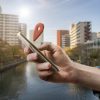
According to the latest Altagamma-McKinsey study the Online shopping of luxury goods in the past five years have reached the industry's overall 6% but will rise to 18% in 2025. Italy, still a little behind the other countries in the rankings, sees Great Britain in first place. As for the best-selling products, cosmetics wins the race.
Marco Catena and Nathalie Remy, both from McKinsey & Company, presented the results of the fourth edition of the Digital Luxury Experience market survey, carried out on 6,400 core luxury consumer, interviewed in eight different markets internationally (Brazil, China, South Korea, France, Japan, Italy, United Kingdom, United States).
«The digital experience is confirmed more than ever central in the decision-making process of the luxury consumer - said Marco Catena -. Suffice it to say that even the 68% of high-end sales made offline are influenced by digital channels, especially by single-brand sites (38% of the total) ».
Although Italy is not at the head of the Online shopping luxury, it is estimated that this year at least one in five purchases will be made online.
The luxury shopping it might seem like a world little led to the digitization of its exclusive products. We always think of the elite sector that traditionally buys in boutiques, those shops accessible only to wealthy people. In the case of Italy, on the other hand, the luxury market is comfortably landing on the network and even online purchases in this sector are increasing, as the data in the last five years show with the increase of 27%.
A very relevant figure that came out of the survey Digital Luxury Experience connects users of online purchases of luxury goods to a very frequent use of social media: the 80% uses social platforms at least once a month, the 50% every week, the 25% daily. Furthermore, this consumer sector appears to be the most technological, “The 95% of respondents own a mobile device, compared to an average of 60% in the American population. And again, the 75% has more than one, against an average of 33% ”, stated Marco Catena. Thanks to the widespread use of smartphones and tablets and sharing via various social media, the expectations of luxury customers in the digital world have increased in recent times.
This clientele is not only made up of young people, but two different age groups are identified: generation Y (18-35 years old) and the over 65s, who spend almost the same hours on the internet and use social media for almost the same percentage.
In our country, only 6% of sales are digital, compared to the UK's 11%, the country where you buy the most online, and the 2% of the country in the queue, Brazil. However, the digital impact is stronger every time and helps in the process by which consumers conclude the purchase in physical stores.
"In 68% of cases, or almost three times out of four, offline sales are influenced by online: just think that out of 21 points of contact that brands use to engage customers, at least half are digital, such as blogs, newsletters , social media and apps, ”explains Nathalie Remy, the other head of McKinsey's studio.
Year after year we will see an increase in the number of companies joining the ship of the Internet to promote its luxury products and many of them afford to avoid physical stores in this way.
«It is fundamental know how to innovate and distinguish in the experience offered to the various consumers in a multichannel context - concluded Catena -. To do this, brands will have to integrate digital into their operating model, invest in specialists and technological infrastructures. All this by creating a transformation in line with the corporate culture ».











